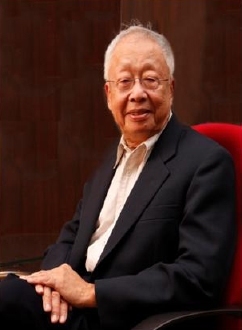MIT Professor Emeritus Kerson Huang, who was well known for his contributions to the field of statistical physics, passed away on Sept. 1 at the age of 88. He had recently been in hospice care at Kaplan House in Danvers, Massachusetts.
Born March 15, 1928, in Nanning, Kwangsi, China, Huang spent his youth primarily in Manila, Philippines. He received his BS in physics in 1950 and his PhD in 1953, both from MIT. He was one of the most prominent advisees of Austrian-American theoretical physicist Victor Weisskopf. Huang served as an instructor at MIT from 1953 to 1955 before spending two years as a fellow at the Institute for Advanced Study. He returned to MIT in 1957 as an assistant professor in physics and was promoted to associate professor in 1961 and to professor in 1966. He was part of the first faculty of the Center for Theoretical Physics (CTP) when it was inaugurated in 1968, and was also a researcher in the Laboratory for Nuclear Science.
Together with C. N. Yang, T. D. Lee, and others, Huang contributed to the development of the consistent many-body description of interactions of identical particles such as helium atoms. With Steven Weinberg, Huang showed that the spectrum of strongly interacting particles is so rich that it implies that there is an ultimate temperature above which the description in terms of hadrons breaks down. Together with T. D. Lee and C. N. Yang and separately with Francis Low, Huang wrote important papers on the nature of the weak interaction, especially the way in which then newly-discovered parity violation could be observed experimentally. His books, "Introduction to Statistical Physics" and "Statistical Physics," are widely used throughout the world as fundamental texts in the field.
In addition to his many physics accomplishments, Huang was a broadly engaged intellectual who translated Chinese poetry into English and vice versa. His translations include "The Rubaiyat of Omar Khayem: A Rendition in Classical Chinese Quatrains;" "I, Ching, the Oracle;" and "I Ching" (with Rosemary Huang). He also published several books of his own poetry in Chinese.
After Huang became a professor emeritus in 1999, he remained with the CTP until 2005 before retiring to Florida. In recent years, he had been a visiting professor at Nanyang Technical University in Singapore.
Huang was a fellow of both the American Physical Society and the American Academy of Arts and Letters. During his career, he was the recipient of fellowships from the Alfred P. Sloan, John Simon Guggenheim, and Fulbright Foundations.
He is survived by his daughter, Kathryn Camille Huang, and by his former wife, Rosemary Huang. Prior to entering hospice, Huang most recently resided in Wakefield, Massachusetts. By his own request, there will be no memorial service.






